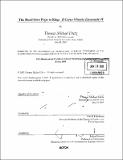| dc.contributor.advisor | David Friedman. | en_US |
| dc.contributor.author | Dietz, Thomas Michael, S.M. Massachusetts Institute of Technology | en_US |
| dc.contributor.other | Massachusetts Institute of Technology. Dept. of Architecture. | en_US |
| dc.date.accessioned | 2006-07-31T15:16:07Z | |
| dc.date.available | 2006-07-31T15:16:07Z | |
| dc.date.copyright | 2005 | en_US |
| dc.date.issued | 2005 | en_US |
| dc.identifier.uri | http://hdl.handle.net/1721.1/33601 | |
| dc.description | Thesis (S.M.)--Massachusetts Institute of Technology, Dept. of Architecture, 2005. | en_US |
| dc.description | Vita. | en_US |
| dc.description | Includes bibliographical references (p. 84-88). | en_US |
| dc.description.abstract | The formal unification of the Kingdom of Italy in 1861, and the later addition of the Roman capital in 1870, sparked criticism from Papal authorities and fostered a growing secularist sentiment among royal political leaders. Yet the Kingdom of Italy also sought to mediate those differences, having formed a liberal constitutional monarchy under the former King of Savoy, Carlo Alberto (and later, his son, Vittorio Emanuele II). This thesis will address the urban manifestation of the conflicted relationship between the Papacy and the new royal government of the Kingdom of Italy in Rome, with a particular regard for the manner in which the Corso Vittorio Emanuele II portrays the Risorgimento king. The Corso Vittorio Emanuele II also serves as the means by which French and British models operative in Italy can be evaluated, with the consequences of this urban intervention analyzed in relation to the particular practice of conservation employed in Italy at the conclusion of the nineteenth-century. The history of this urban intervention will first be indexed against three successive periods in the royal Italian government (the Destra, Sinistra, and Giolittian parliaments), all of which proposed differing visions for the new capital. The history of Roman urban planning will then be considered with regard to the pre-Risorgimento initiatives of Pope Pius IX and Cardinal Merode, the municipal :Development Plan of 1873, and the later royal Development Plan of 1883 (the plan that generally defined the avenue's construction). | en_US |
| dc.description.abstract | (cont.) The Corso Vittorio Emanuele II will then be investigated in greater depth, paying particular attention to the Development Plans of 1873 and 1883, the official Variant of 1886 (which was actually built), and a selection of other unofficial counterproposals. The intention is to demonstrate that the Italian admiration for British political and conservation models- which do have a common philosophical basis-were somewhat contradictory in application, resulting in a uniquely modern approach to urbanism in Rome and a surprisingly respectful treatment of ecclesiastical structures (even despite the ongoing conflict between Papal and royal authorities). | en_US |
| dc.description.statementofresponsibility | by Thomas Michael Dietz. | en_US |
| dc.format.extent | 88 p. | en_US |
| dc.format.extent | 8221452 bytes | |
| dc.format.extent | 8225678 bytes | |
| dc.format.mimetype | application/pdf | |
| dc.format.mimetype | application/pdf | |
| dc.language.iso | eng | en_US |
| dc.publisher | Massachusetts Institute of Technology | en_US |
| dc.rights | M.I.T. theses are protected by copyright. They may be viewed from this source for any purpose, but reproduction or distribution in any format is prohibited without written permission. See provided URL for inquiries about permission. | en_US |
| dc.rights.uri | http://dspace.mit.edu/handle/1721.1/7582 | |
| dc.subject | Architecture. | en_US |
| dc.title | The road from pope to king : il Corso Vittorio Emanuele, II | en_US |
| dc.type | Thesis | en_US |
| dc.description.degree | S.M. | en_US |
| dc.contributor.department | Massachusetts Institute of Technology. Department of Architecture | |
| dc.identifier.oclc | 64178282 | en_US |
